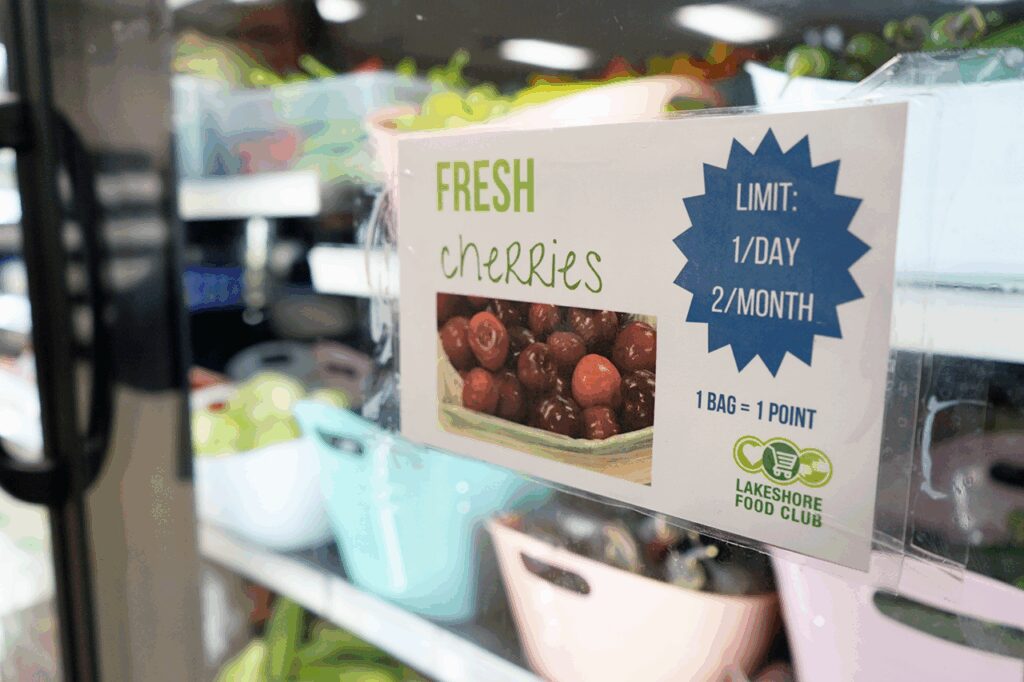
Partners across Michigan, including food banks, pantries, retailers, and farmers, have taken critical steps to prioritize dignity and individual choice in our state’s charitable food systems.
Earlier this year, we shared how Michigan’s food clubs are putting an innovative spin on these concepts, engaging families as members and connecting them with nutritious, local foods through a grocery hub model. Read our previous post to find out how it works.
Michigan is currently home to three food clubs, all Health Fund grantees, that source food through partnerships with food banks, reclaimed retail sources, and purchases at market value — often from local farmers and producers. Each club has built its own unique approach that responds to its local context and community needs.
COMMUNITY FOOD CLUB — GRAND RAPIDS
Community Food Club (CFC) is the state’s first food club, formed in 2015 by a coalition of seven partner organizations in Grand Rapids looking to build a new approach to food access. It provided inspiration and mentorship for the other clubs that followed.
CFC serves a large and diverse member base in Grand Rapids. Open to all Kent County residents, the CFC is serving 300 households each day and 17,000 people annually — approximately 10% of the food insecure individuals in Kent County — and demand is growing.
Approximately 60% of the food club’s inventory is made up of perishable items — produce, meat, eggs, etc. — reflecting a focus on nutritious food to help members maintain health and manage diet-related chronic disease. Input from members also drives CFC’s product choices, with reliable availability of culturally appropriate and allergy-specific foods among the daily offerings.
On a given day, CFC can move 20 pallets of donated or locally purchased food. Executive Director AJ Fossel cites these efficiencies of scale as a key part of the food club’s success, but the model’s emphasis on equity and dignity for the families served is what makes it special.
“I think dignity should be viewed as a social determinant of health. It affects how people interact with their food,” she said. “Members, staff, volunteers, we all look each other in the eye. We share life in this space together.”
COMMUNITY ACTION HOUSE — HOLLAND
Community Action House (CAH) has added several additional features to the food club model developed in Grand Rapids. In addition to a grocery store-style space, CAH has developed a large, sophisticated facility equipped to serve as a food hub for the region. This has led to a major operation in food rescue and redistribution in Ottawa County and throughout West Michigan, serving many other pantries and partners.
In the last year, CAH rescued, sorted, and shared 3.7 million pounds of rescued food — food fit to consume, but slated for disposal in landfills by producers and retailers. Operational efficiency and a large volunteer workforce are critical to CAH’s success.
The facility also features a co-located ‘Opportunity Hub’ that connects members to services for housing, financial empowerment, and other social determinants of health. Members benefit from streamlined access to CAH’s Healthy @ Home, Resource Navigation, Financial Wellness, and Housing Access programming. But the Opportunity Hub also provides a space for a variety of other services – last year, 17 other partner agencies provided their own services on-site.
“We’ve combined a strong operational, back-of-house focus together with a focus on serving clients, which has really grown our impact,” Rumpsa said. “Building a space where our members feel respected makes it easier to build the trust you need to connect them with other forms of support.”
LAKESHORE FOOD CLUB — LUDINGTON
Lakeshore Food Club (LFC) operates in a more rural community context than its counterparts, as well as a region with rich agricultural resources.
This has helped support close ties to local food growers and producers, along with an expanding food rescue and distribution operation that is growing its impact beyond the club’s primary home in Ludington, which serves a member base of more than 3,000 out of a modestly sized market location.
In June, LFC purchased a warehouse facility in Hart with sizable cold storage capacity that Executive Director O’Nealya Gronstal plans to operate as a hub, preserving larger volumes of donated produce, creating revenue opportunities through agreements with local farmers, and distributing food to other food assistance partners across the region.
“By operating this food hub, we are really becoming a catalyst for food security in our region,” Gronstal said. “I’m sitting in the agricultural heart of Michigan. We’re working to connect families with the amazing food resources we have here, but that are often out of their reach.”
Additionally, LFC is leading an innovative effort to operate satellite food clubs out of two schools in Scottville. School food hubs are operated by student volunteers and provide youth and families with another avenue to food access.
LEARNING AND SCALING
We’ve been excited to support the efforts of these three organizations. In September, the Health Fund invested a $500,000 grant to consolidate the impact of our past investments and accelerate development of a statewide network to strengthen and expand the food club model in Michigan.
Over the next two years, this support will help the Food Club Network — which launched in 2023 and has been housed at CFC — to become an independent entity, provide resources and technical assistance to new and existing sites, and grow health care partnerships that link food access with better health outcomes through new Medicaid provisions. This includes assisting the launch of a new food club in Saginaw in 2026.
With major changes in federal food assistance programs underway, the continued growth and evolution of food clubs will be a critical storyline in the effort to meet families’ nutrition and food security needs. We’re excited to see how our latest investment helps move the model forward.
To learn more about the food club model and the partners featured here, visit foodclubnetwork.org.
